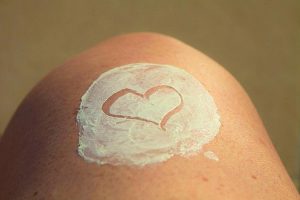
The world of ballroom dancing is famous for its liberal use of fake tan, but the popularity of self tanning products continues to increase as more and more of us want to fake a golden glow in time for a big night out, holiday or festival.
We all know our skin’s greatest enemy is the sun. Developing a real tan works by exposing your skin to UV radiation. This damages and ages your skin and increases your risk of developing skin cancer.
Since many people equate a bronze glow with good health, the search for alternative tans is big business. We are often led to believe that the only safe way to get that sun-kissed look and prevent skin damage is from a self-tanner, but is it?
In this article we will discuss how fake tan products work, whether there are any risks attached to using them and how we can use them safely.

How does Fake Tan Work?
The active ingredient in all tanning products is a molecule called dihydroxyacetone, or DHA.
DHA occurs naturally in all cells. It is a simple sugar that appears as one of the intermediates as cells break down glucose for release energy.
DHA reacts with amino acids. There are 20 different amino acids, and each reacts to produce a slightly different melanoidin molecule. These range in colour from yellow/orange to brown.
When you apply a self-tanning product containing DHA, it reacts with the amino acids in the outermost, dead cell layer of the skin producing a range of yellow/brown melanoidins. The reaction starts a couple of hours after you apply the self-tanner, and continues for up to 72 hours.
This reaction is known as the Maillard reaction. If you’re into food chemistry, this reaction will be very familiar as it’s responsible for the browning on foods when we toast bread or grill meat.
Your resulting tan can last up 10 days, but will start to fade within three to seven days as the melanoids are only present in the top layer of the skin which you slowly shed.
Is it Safe?
Although DHA has been widely approved as safe to apply to skin, there are some emerging health concerns related to excessive use of these products.
Research has found that self tanners, just like exposure to UV light, can generate damaging free radicals. These are highly reactive molecules that attack cell structures and age skin by degrade collagen and elastin fibres.
Perhaps surprisingly this study found that if you go out in the sun after applying self-tanner, you’ll be exposed to even more of them, because UV rays make DHA more unstable.
DHA has also been linked to DNA damage. Research into the long-term use of self-tanning products has raised some safety concerns and it is clear more research is needed in this area.
Research has found regular use of self-tanner can reduce your body’s ability to make vitamin D. Studies have also shown that for some people, self-tanner can result in significant skin irritation and dermatitis .
The rise of spray tanning is also causing concern. It appears that spray tans may be riskier than self-tanners because in a spray booth DHA can get into the lungs and cause significant harm to your respiratory system. Some preliminary studies suggest it may increase the risk of asthma, COPD and some cancers.
To reduce these harmful effects, it is a good idea to apply your tanning product at night. This study suggests free radical production is reduced four hours after application. You should always use a broad-spectrum sunscreen SPF 30+ when you are out and about and could consider using a vitamin C face serum. Vitamin C is a powerful antioxidant which will minimize free radical damage.
Are There Safer Self-Tanning Products on the Market?
Given the research linking DHA to a range of health concerns there are new “DHA-free” tanning products on the market which promise a gentler, more gradual tan.
In fact the active ingredient in these DHA-free self-tanners is erythrulose. This molecule is very similar in composition to DHA and has also been shown to increase production of free radicals.
This means they could still cause skin aging, DNA damage, skin irritation and lowered vitamin D production just like the the DHA containing products.
Another alternative is the new generation of wash-off bronzers.
Applied directly to bare skin along with your usual skincare products, or sunscreen, these deliver instant colour that mimics a natural tan.
You don’t have to wait for the tan to develop, good quality products won’t rub off onto your clothes, and you can wash them off when you want with regular soap and water.
They are a very good way to get a glow whilst avoiding the potentially harmful effects of self-tanning products.
The take home message is using self-tanning products is not entirely risk free and can have negative impacts on your skin.
It may be wise to save them for special occasions and avoid using them every day. Wash-off bronzers provide the same effect without any of the risks.
It is worth noting that DHA is currently approved for external use only, excluding the lips, eyes, ears, nose, and mucous membranes. This excludes spray tans as DHA is not approved for inhalation. With this in mind spray tans should be approached with more caution.

Leave a Reply